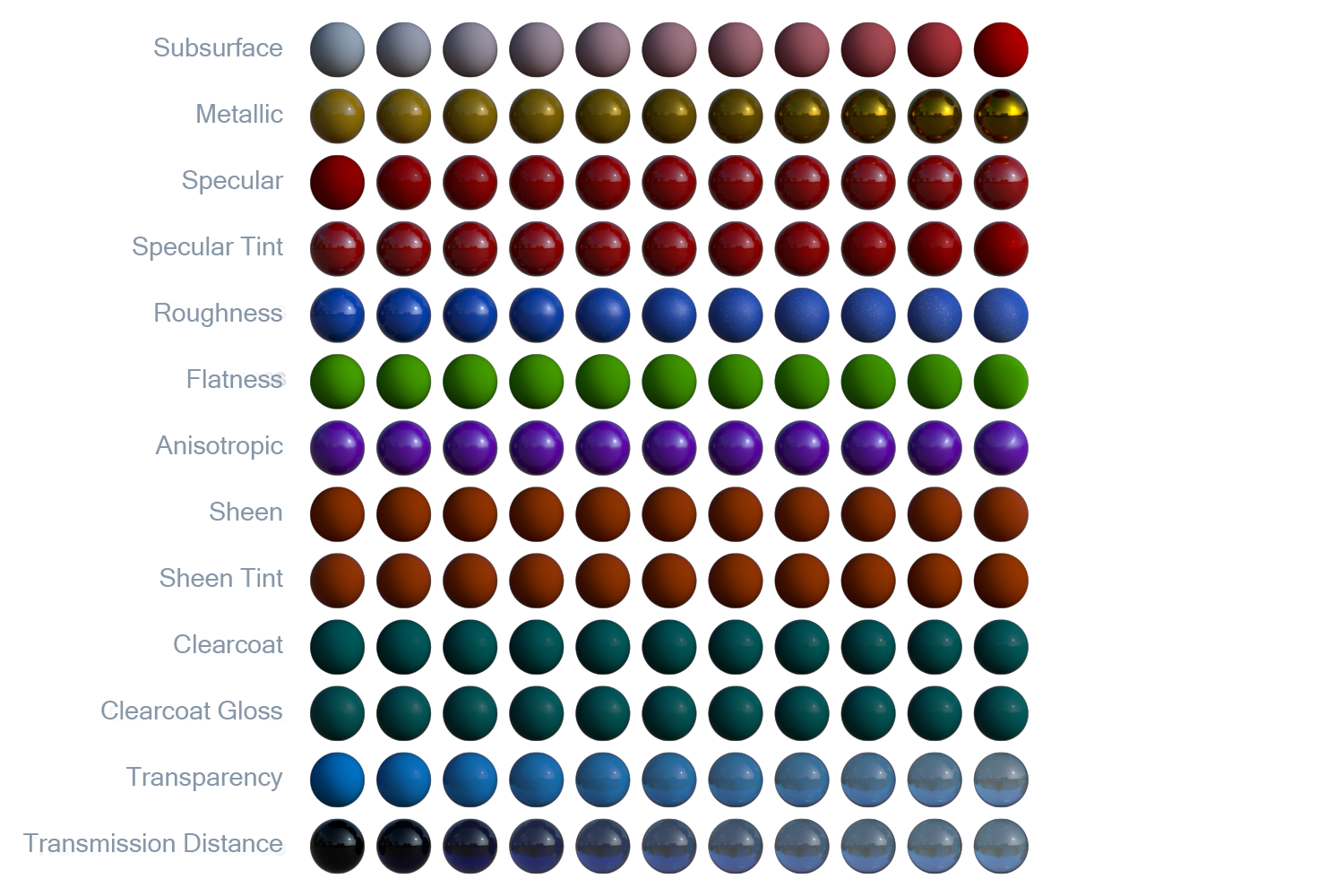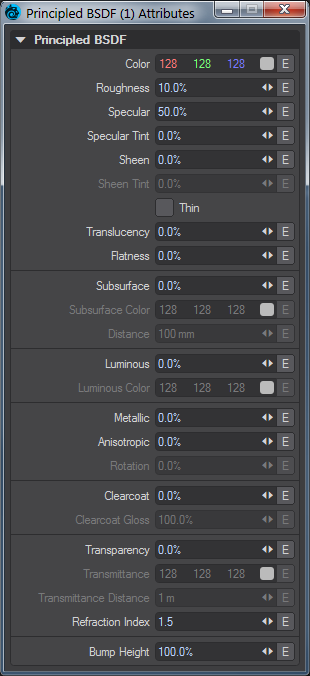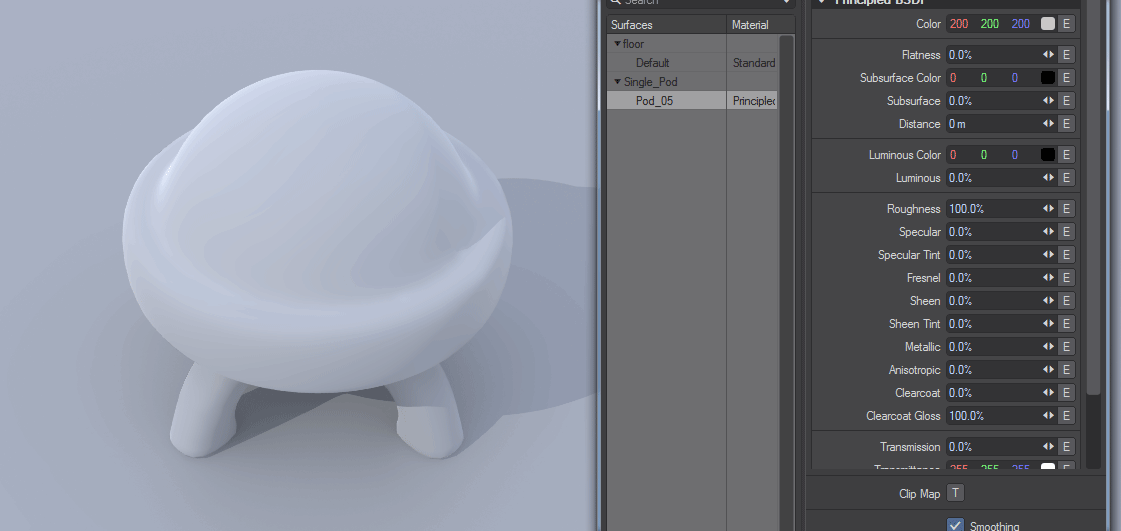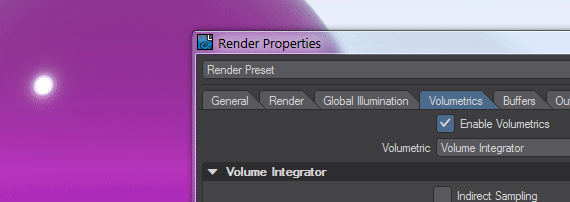Principled BSDF
Principled BSDF
This material is physically plausible* and can be used exclusively for predictably texturing a whole scene. With it, you can create plastics, glass, metal and plenty of other surface types. By doing so, you will create consistent, predictable surfaces that will react to light and other scene elements the same way every time. BSDF stands for Bidirectional Scattering Distribution Function.
Lemons! by Dave Tracey (using PBSDF)
Three examples of surfacing using the Principled BSDF material. Only settings in the panel have been changed; no inputs have been filled.
Edit Panel
Color (Color)
The surface color, often supplied by texture maps.
Roughness (Scalar)
This setting is usually paired with Specularity and defines how tight the reflection will be. A high roughness will mean that the surface might be reflective but the reflection will be diffused and unrecognizable.
Specular (Scalar)
Specularity is the correct term for reflection. Normally all surfaces have some element of incident reflection and this setting is usually accompanied by a Roughness setting (in the Standard material this accompanying setting is called Glossiness and works in the opposite direction - 100 % Glossiness is the same as 0 % Roughness).
Also, for artistic freedom, setting Specular at 0 % turns off the Fresnel function for entirely matte surfaces. The following animation shows this clearly. Specular is progressively lowered, but even at 0.1 %, the fresnel effect of a slight sheen at the edge of the sphere is visible. Only when Specular is at exactly 0 % is the sphere completely matte.
Specular Tint (Scalar)
A concession for artistic control that tints incident specular towards the base color. Grazing specular is still achromatic.
Sheen (Scalar)
An additional grazing-angle component (primarily for cloth)
Sheen Tint (Scalar)
Amount to tint sheen towards base color.
Thin
Thin mode makes translucency function, so you can use that instead of subsurface scattering, for making leaves from single thickness objects with double sided turned on.
Translucency
The amount of translucency to use with the Thin switch.
Flatness (Scalar)
Flatness is an alternate, flatter diffuse shape. The effect is subtle and not always easy to see when combined with other material properties. The example has 100 % Roughness, 0 % Specular and 0 % Fresnel.
Subsurface (Scalar)
Defines how much you want your subsurface color to be visible. If you set this to 100 % it completely replaces the surface color.
Subsurface Color (Color)
The subsurface color you want under the surface of your material. The quantity of visible subsurface color is defined by the following two options:
Distance (Scalar)
How far "into" the surface before the subsurface color is seen. If you make this value larger than the object that uses this material then the subsurface scattering will not be visible.
Luminous (Scalar)
How luminous your material is. This value can far exceed the 0-100 % range.
Luminous Color (Color)
The color with which your surface will glow. As normal, glowing objects only light others if GI is used.
Metallic (Scalar)
The metallic-ness (0 = dielectric, 1 = metallic) - this is a linear blend between two different models. The metallic model has no diffuse component and also has a tinted incident specular, equal to the base color.
Anisotropy (Scalar)
Anisotropy is a bias in the direction of lighting a surface. At 0 % a surface is isotropic, meaning there's no bias. As you approach 100 % your surface will become maximally anisotropic. Some degree of Roughness is necessary for anisotropy to be visible, and the amount tells the anisotropic highlight how far to "spread".
Anisotropy requires that there is a Projection node input otherwise you will get strange polygonal shapes in the render.
Left: Anisotropy at 100 %, Rotation at 15 %, Roughness at 30 %. Right: No Projection
Rotation (Scalar)
This determines the angular rotation for your anisotropic highlights. At 0 % the rotation will follow the curve of your object and at 50 % will be perpendicular to it.
Clearcoat (Scalar)
Clearcoat Gloss (Scalar)
Transparency (Scalar)
The amount of transparency for the surface.
Transmittance (Color)
The transmittance of a material is its effectiveness in transmitting light - how transparent it is - and what color light it transmits through the material it is paired with.
Transmittance Distance (Scalar)
This is the distance at which the medium absorption color reaches Transmittance Color.
Transmittance requires Volumetrics to be enabled; otherwise, there will be no color.
Refraction Index (Scalar)
When there is some level of Transmittance (Transparency), this determines how light passing through the medium is bent.
Bump Height (Scalar)
Specifies the bump height or “amplitude” of the Bump directional vectors.
* Physically plausible materials forgo 100 % reciprocality for artistic control. For PBSDF, the fact that a 0% Specular turns off the Fresnel effect, is not strictly accurate but it works well for artistic purposes. However, for almost all other values, PBSDF is energy conserving and designed to mimic real-world materials.
Video











